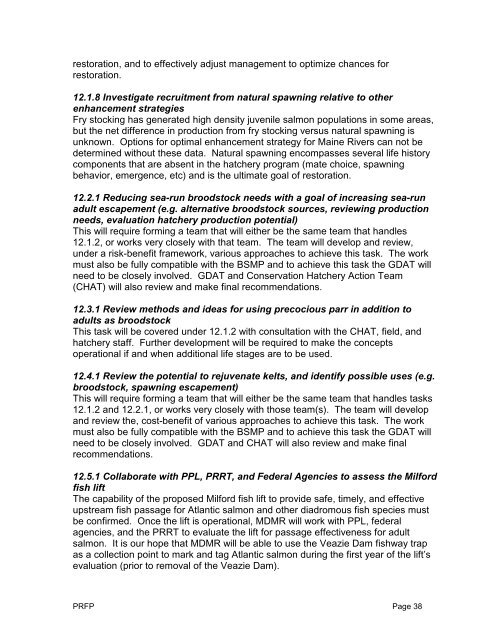Operational Plan for the Restoration of Diadromous Fishes to the ...
Operational Plan for the Restoration of Diadromous Fishes to the ...
Operational Plan for the Restoration of Diadromous Fishes to the ...
Create successful ePaper yourself
Turn your PDF publications into a flip-book with our unique Google optimized e-Paper software.
es<strong>to</strong>ration, and <strong>to</strong> effectively adjust management <strong>to</strong> optimize chances <strong>for</strong><br />
res<strong>to</strong>ration.<br />
12.1.8 Investigate recruitment from natural spawning relative <strong>to</strong> o<strong>the</strong>r<br />
enhancement strategies<br />
Fry s<strong>to</strong>cking has generated high density juvenile salmon populations in some areas,<br />
but <strong>the</strong> net difference in production from fry s<strong>to</strong>cking versus natural spawning is<br />
unknown. Options <strong>for</strong> optimal enhancement strategy <strong>for</strong> Maine Rivers can not be<br />
determined without <strong>the</strong>se data. Natural spawning encompasses several life his<strong>to</strong>ry<br />
components that are absent in <strong>the</strong> hatchery program (mate choice, spawning<br />
behavior, emergence, etc) and is <strong>the</strong> ultimate goal <strong>of</strong> res<strong>to</strong>ration.<br />
12.2.1 Reducing sea-run broods<strong>to</strong>ck needs with a goal <strong>of</strong> increasing sea-run<br />
adult escapement (e.g. alternative broods<strong>to</strong>ck sources, reviewing production<br />
needs, evaluation hatchery production potential)<br />
This will require <strong>for</strong>ming a team that will ei<strong>the</strong>r be <strong>the</strong> same team that handles<br />
12.1.2, or works very closely with that team. The team will develop and review,<br />
under a risk-benefit framework, various approaches <strong>to</strong> achieve this task. The work<br />
must also be fully compatible with <strong>the</strong> BSMP and <strong>to</strong> achieve this task <strong>the</strong> GDAT will<br />
need <strong>to</strong> be closely involved. GDAT and Conservation Hatchery Action Team<br />
(CHAT) will also review and make final recommendations.<br />
12.3.1 Review methods and ideas <strong>for</strong> using precocious parr in addition <strong>to</strong><br />
adults as broods<strong>to</strong>ck<br />
This task will be covered under 12.1.2 with consultation with <strong>the</strong> CHAT, field, and<br />
hatchery staff. Fur<strong>the</strong>r development will be required <strong>to</strong> make <strong>the</strong> concepts<br />
operational if and when additional life stages are <strong>to</strong> be used.<br />
12.4.1 Review <strong>the</strong> potential <strong>to</strong> rejuvenate kelts, and identify possible uses (e.g.<br />
broods<strong>to</strong>ck, spawning escapement)<br />
This will require <strong>for</strong>ming a team that will ei<strong>the</strong>r be <strong>the</strong> same team that handles tasks<br />
12.1.2 and 12.2.1, or works very closely with those team(s). The team will develop<br />
and review <strong>the</strong>, cost-benefit <strong>of</strong> various approaches <strong>to</strong> achieve this task. The work<br />
must also be fully compatible with <strong>the</strong> BSMP and <strong>to</strong> achieve this task <strong>the</strong> GDAT will<br />
need <strong>to</strong> be closely involved. GDAT and CHAT will also review and make final<br />
recommendations.<br />
12.5.1 Collaborate with PPL, PRRT, and Federal Agencies <strong>to</strong> assess <strong>the</strong> Mil<strong>for</strong>d<br />
fish lift<br />
The capability <strong>of</strong> <strong>the</strong> proposed Mil<strong>for</strong>d fish lift <strong>to</strong> provide safe, timely, and effective<br />
upstream fish passage <strong>for</strong> Atlantic salmon and o<strong>the</strong>r diadromous fish species must<br />
be confirmed. Once <strong>the</strong> lift is operational, MDMR will work with PPL, federal<br />
agencies, and <strong>the</strong> PRRT <strong>to</strong> evaluate <strong>the</strong> lift <strong>for</strong> passage effectiveness <strong>for</strong> adult<br />
salmon. It is our hope that MDMR will be able <strong>to</strong> use <strong>the</strong> Veazie Dam fishway trap<br />
as a collection point <strong>to</strong> mark and tag Atlantic salmon during <strong>the</strong> first year <strong>of</strong> <strong>the</strong> lift’s<br />
evaluation (prior <strong>to</strong> removal <strong>of</strong> <strong>the</strong> Veazie Dam).<br />
PRFP Page 38






